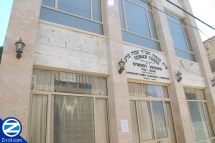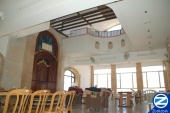Tzemach Tzedek Synagogue Tzfat
(→Chabad in Tzfat) |
|||
| (18 intermediate revisions by 3 users not shown) | |||
| Line 1: | Line 1: | ||
| − | + | {{Infobox | |
| + | |title = Tzemach Tzedek Shul | ||
| + | |image = [[File:00000716 tzemach tzedek chabad shul tzfat.jpg|215px|alt=Tzemach Tzedek Shul]] | ||
| + | |header1 = Hebrew: | ||
| + | |data2 = בית כנסת צמח צדק צפת | ||
| + | |header3 = Pronunciation: | ||
| + | |data4 = tz-em-ach tz-ee-deek | ||
| + | |header3 = Spelling: | ||
| + | |data4 = Zemach Zedek | ||
| + | |header5 = Other Names: | ||
| + | |data6 = Old City Chabad Shul | ||
| + | |header7 = Description: | ||
| + | |data8 = Old Chabad synagogue in Safed, Israel named after 3rd Lubavitcher Rebbe. | ||
| + | }} | ||
| − | The Tzemach Tzedek synagogue in Tzfat is a central | + | The Tzemach Tzedek synagogue in [[Safed|Tzfat]] is a central landmark for the [[Chabad in Safed|local Lubavitch community]]. The Lubavitch Hassidim, also known as “Chabad,” operate a large and growing community outside of the [[Old City Safed|Old City]] on [[Canaan Neighborhood Safed|Mount Canaan]] which dates to the early 1970s. Chabad’s Safed origins, however, can be traced to the Ashkanazi “aliyah” -- immigration -- of the 18th century, along with the Tzemach Tzedek shul on Hatam Sofer Street. |
| − | == | + | == Chabad Chassidus Origins == |
| − | The Chassidic movement originated in the early 18th century in an area near the Polish/Ukrainian border. The Grand Master of the movement, the “Ba’al Shem Tov” taught that, contrary to the prevailing emphasis of the day, Jewish scholarship was not the only way to please God. Hassidic philosophy emphasized the importance of serving God through joyful and heartfelt worship and service. | + | [[File:00000717 inside tzemach tzedek synagogue.jpg|thumb|170px|left|Inside Tzemach Tzedek.]]The Chassidic movement originated in the early 18th century in an area near the Polish/Ukrainian border. The Grand Master of the movement, the “Ba’al Shem Tov” taught that, contrary to the prevailing emphasis of the day, Jewish scholarship was not the only way to please God. Hassidic philosophy emphasized the importance of serving God through joyful and heartfelt worship and service. Rabbi Shneur Zalman of Lidai was a follower of the Hasidic movement during its third generation. Rabbi Shneur Zalman, known as the “Alter Rebbe,” went on to establish a new branch of the movement called Chabad, which combined Torah scholarship with Hassidic philosophy. After Rabbi Shneur Zalman’s death, his son Dov Baer, accepted the mantle of Chabad leadership. Rabbi Dov Baer settled, together with his followers, in the town of Lubavitch in White Russia. |
| − | == Immigration to Tzfat | + | == Immigration to Tzfat == |
In 1777 Ashkanazi -- Eastern European -- Jews began to immigrate to Israel in large numbers. Hassidic Jews, including followers of the Chabad movement, paved the way, encouraged by Rabbi Shneur Zalman. The Hassidim traveled with Rabbi Menachem Mendel of Vitebsk and established communities in Tzfat and Tiberias. Their immigration received financial support through the efforts of Rabbi Shneur Zalman who had remained in Moholiev Russia. | In 1777 Ashkanazi -- Eastern European -- Jews began to immigrate to Israel in large numbers. Hassidic Jews, including followers of the Chabad movement, paved the way, encouraged by Rabbi Shneur Zalman. The Hassidim traveled with Rabbi Menachem Mendel of Vitebsk and established communities in Tzfat and Tiberias. Their immigration received financial support through the efforts of Rabbi Shneur Zalman who had remained in Moholiev Russia. | ||
| − | == Chabad in Tzfat | + | == Chabad in Tzfat == |
| − | In the early 1800s the third Lubavitcher Rebbe, known as the “Tzemach Tzedek” acquired the land for a synagogue in Safed in the eastern sector of the Jewish Quarter. His followers built the shul and named it the “Tzemach Tzedek.” The synagogue served the community for many years as | + | In the early 1800s the third Lubavitcher Rebbe, known as the “Tzemach Tzedek” acquired the land for a synagogue in Safed in the eastern sector of the [[Old City Safed|Jewish Quarter]]. His followers built the shul and named it the “Tzemach Tzedek.” The synagogue served the [[Chabad in Safed|Chabad community]] for many years as the central Chabad site of Tzfat. By the early 20th century the entire Tzfat Jewish population began to decline due to disease, economic stress and famine. At this point the Tzemach Tzedek synagogue fell into disrepair. |
| − | The seventh Chabad Rebbe, Menachem Mendel Schneerson, sent emissaries to Tsfat in 1972 to reestablish the Chabad presence in the city. In addition to directing his followers to establish schools and a “Kiriyah” -- apartment community -- the Rebbe requested that his followers renovate and revitalize the Tzemach Tzedek synagogue. | + | The seventh Chabad Rebbe, Menachem Mendel Schneerson, sent emissaries to Tsfat in 1972 to reestablish the Chabad presence in the city. In addition to directing his followers to establish schools and a “Kiriyah” -- apartment community -- the Lubovitcher Rebbe requested that his followers renovate and revitalize the Tzemach Tzedek synagogue. |
| − | The renovations were completed in the early years of the 21st century and the synagogue, located on a lane below the commercial Jerusalem Street, is open throughout the day for prayers and study. A kollel and yeshivah | + | The renovations were completed in the early years of the 21st century and the synagogue, located on a lane below the commercial [[Jerusalem Street Safed|Jerusalem Street]], is open throughout the day for prayers and study. A kollel and yeshivah [[Tememei Derech Yeshivah Safed|Tememei Derech]], maintain full-time Torah studies for students as well as drop-ins. Tzfat’s Old City Chabad House, located a few yards away from the Tzemach Tzedek is open for classes and other outreach activities. |
| + | |||
| + | |||
| + | {{Tzfat Synagogues}} | ||
| + | {{Claim Page}} | ||
| + | |||
| + | [[Category:Old Synagogues]] | ||
| + | [[Category:Safed]] | ||
| + | [[Category:Chabad]] | ||
Latest revision as of 20:38, 15 April 2013
 | |
| Hebrew: | |
|---|---|
| בית כנסת צמח צדק צפת | |
| Spelling: | |
| Zemach Zedek | |
| Other Names: | |
| Old City Chabad Shul | |
| Description: | |
| Old Chabad synagogue in Safed, Israel named after 3rd Lubavitcher Rebbe. |
The Tzemach Tzedek synagogue in Tzfat is a central landmark for the local Lubavitch community. The Lubavitch Hassidim, also known as “Chabad,” operate a large and growing community outside of the Old City on Mount Canaan which dates to the early 1970s. Chabad’s Safed origins, however, can be traced to the Ashkanazi “aliyah” -- immigration -- of the 18th century, along with the Tzemach Tzedek shul on Hatam Sofer Street.
[edit] Chabad Chassidus Origins
The Chassidic movement originated in the early 18th century in an area near the Polish/Ukrainian border. The Grand Master of the movement, the “Ba’al Shem Tov” taught that, contrary to the prevailing emphasis of the day, Jewish scholarship was not the only way to please God. Hassidic philosophy emphasized the importance of serving God through joyful and heartfelt worship and service. Rabbi Shneur Zalman of Lidai was a follower of the Hasidic movement during its third generation. Rabbi Shneur Zalman, known as the “Alter Rebbe,” went on to establish a new branch of the movement called Chabad, which combined Torah scholarship with Hassidic philosophy. After Rabbi Shneur Zalman’s death, his son Dov Baer, accepted the mantle of Chabad leadership. Rabbi Dov Baer settled, together with his followers, in the town of Lubavitch in White Russia.[edit] Immigration to Tzfat
In 1777 Ashkanazi -- Eastern European -- Jews began to immigrate to Israel in large numbers. Hassidic Jews, including followers of the Chabad movement, paved the way, encouraged by Rabbi Shneur Zalman. The Hassidim traveled with Rabbi Menachem Mendel of Vitebsk and established communities in Tzfat and Tiberias. Their immigration received financial support through the efforts of Rabbi Shneur Zalman who had remained in Moholiev Russia.
[edit] Chabad in Tzfat
In the early 1800s the third Lubavitcher Rebbe, known as the “Tzemach Tzedek” acquired the land for a synagogue in Safed in the eastern sector of the Jewish Quarter. His followers built the shul and named it the “Tzemach Tzedek.” The synagogue served the Chabad community for many years as the central Chabad site of Tzfat. By the early 20th century the entire Tzfat Jewish population began to decline due to disease, economic stress and famine. At this point the Tzemach Tzedek synagogue fell into disrepair.
The seventh Chabad Rebbe, Menachem Mendel Schneerson, sent emissaries to Tsfat in 1972 to reestablish the Chabad presence in the city. In addition to directing his followers to establish schools and a “Kiriyah” -- apartment community -- the Lubovitcher Rebbe requested that his followers renovate and revitalize the Tzemach Tzedek synagogue.
The renovations were completed in the early years of the 21st century and the synagogue, located on a lane below the commercial Jerusalem Street, is open throughout the day for prayers and study. A kollel and yeshivah Tememei Derech, maintain full-time Torah studies for students as well as drop-ins. Tzfat’s Old City Chabad House, located a few yards away from the Tzemach Tzedek is open for classes and other outreach activities.
| |||||||||||



